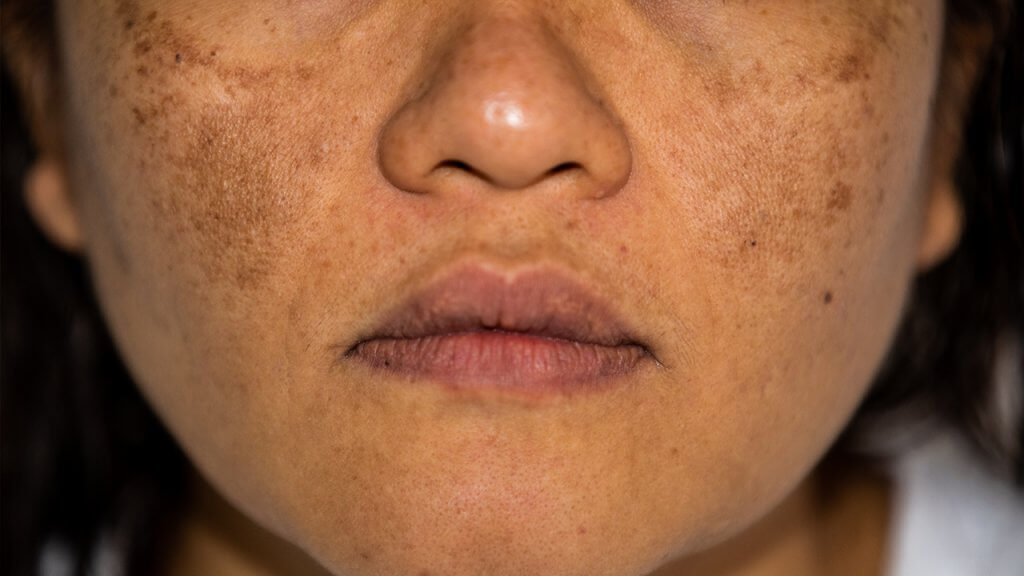Causes
Radiation from the Sun
Sunlight includes visible light, infrared light, and ultraviolet rays A, B and C. Ultraviolet ray C is isolated by the earth’s ozone because of its shortest wavelength, while Ultraviolet rays A and B can reach the surface of the earth through the ozone layer.
Ultraviolet B will be isolated by a glass window, and ultraviolet A will pass through the glass windows to reach inside the house. Moreover, it can penetrate the skin surface to damage the skin and cause the formation of pigmentation.
Genetics
Everyone has different skin colours, textures and rates of ageing due to genetics. Parents with darker skin tones will not give birth to children with fair skin. For example, because our melanin synthesis genes are different, some people tanned easier and some people aged faster. Some ethnic backgrounds are more prone to pigmentations, such as Asians and Indians.
City Life
Daily exposure to air pollution, smoking, exhaust etc. can lead to the formation of an excessive amount of free radicals, causing inflammation and activation of melanocytes causing the formation of pigmentations
Changes in Hormone Levels or Hormonal Changes
For women during pregnancy or menstruation, pigmentations may be formed due to hormonal changes
Inflammatory Skin Diseases
Acne and Eczema can also cause skin irritation and pigmentation.
Cosmetic Allergy
Some cosmetics that contain fragrances, pigments, and preservatives may cause skin irritations that trigger inflammation and melanin formation.
Types of Pigmentations
Pigmentations can be categorized into epidermis, dermis and combination.
The commonest pigmentation is freckles. Freckles are common in children, and with age, freckles may disappear or become less noticeable. Sunspots are slightly larger than freckles and will also appear brown. It usually appears on the faces of men and women after the age of 30.

Due to ageing, the sunspot will “evolve” into age spots, the thickness will become uneven, and the brown pigmentation will become darker.

Melasma is a pigmentation that occurs in the epidermis and dermis, especially on the cheeks, bridge of the nose, forehead and upper lip, and sometimes on other exposed areas of the body, such as the forearm. The epidermal melasma affects the surface of the skin, characterized by a brown and clear border. The dermis layer of melasma affects the deeper dermis and is characterized by blue-grey pigmentation.

This is often worsened by hormonal changes, ultraviolet radiation, oral contraceptives, and stress. Hori’s Nevus is a kind of dermis pigmentation and often occurs on the cheekbone. It appears as a taupe or blue-grey spot. Hori’s Nevus usually occurs in adulthood and is often mistaken for freckles. It is also the most common pigmentation in Asian middle-aged women.

Another type of pigmentation is PIH (Post-inflammatory Hyperpigmentation ). This spot usually occurs after inflammation of the skin due to hyperpigmentation. It may also occur after the use of an inappropriate laser treatment.
Recommended Aesthetic Treatments
Discovery PICO Laser is a non-ablative laser that is used for pigmentation removal, acne scars, skin rejuvenation and brightening, and tattoo removal. Discovery PICO is different from traditional Q-Switched lasers because it can generate higher power laser energy in shorter bursts (picosecond versus nanosecond bursts of Q-Switched lasers) to fragment pigmented particles into a thin “dust”, breaking up melanin and pigment particles. By working in picosecond pulses, it minimises heat generated and enables the skin to clear these fragments faster and easier, reducing the number of treatments required.
Excel V Laser is a high-power laser with targeted pulses to repair vascular skin conditions (related to blood vessels) such as Rosacea, spider veins, pigmented lesions such as sun spots and age spots, as well as acne scars, fine lines and enlarged pores.
Featuring two wavelengths of lasers, this customisable ability allows it to simultaneously treat different skin conditions from vascular conditions to benign pigmented lesions, as well as to lift, brighten and overall skin rejuvenation and radiance.
Dual Yellow Laser is an FDA-approved multi-wavelength laser treatment – the green and yellow light is effective for targeting skin concerns such as skin pigmentation particularly melasma, and acne and redness, as well as other vascular lesions such as seborrheic keratosis.
Find out more about the Pigmentation Treatments with our doctor and therapists at Ageless Medical.
Ageless Medical
Tel: +65 6734 4007
WhatsApp (Call/Message): +65 8181 0680
Email: enquiry@iamageless.com.sg




